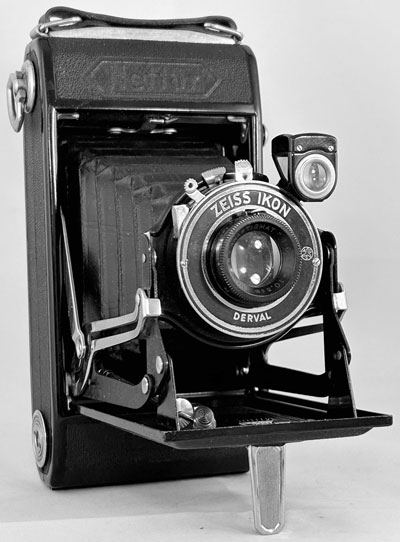Zeiss Ikon Nettar 515/2
Specification

| Manufacturer | : | Zeiss Ikon |
|---|---|---|
| Produced | : | 1933 |
| Classification | : | Medium Format |
| Body Type | : | Folding Bed |
| Bellows Deployment | : | Self Erecting |
| Construction | : | Metal |
| Film Type | : | 120 |
| Film Width | : | 62mm |
| Image Size | : | 6 x 9 cm |
| No. of Images | : | 8 |
| Lens Type | : | Nettar Anastigmat |
| Focus Type | : | Variable |
| Focal Length | : | 105mm |
| Focal Range | : | 2m - inf. |
| Aperture Type | : | Iris |
| Apertures | : | f/6.3 - f/32 |
| Shutter Type | : | Self-cocking leaf |
| Shutter Speeds | : | T,B, I(1/100s, 1/50s, 1/25s) |
| Size Open(w x h x d) | : | 90 x 165 x 130 mm |
| Size Closed(w x h x d) | : | 90 x 165 x 38 mm |
| Weight | : | 569g |
Art Deco Credentials
![]()
![]()
![]()
![]()
Significant: Pronounced and self evident
I consider this camera to warrant 4 stars for the following attributes:
- produced during the main Art Deco period
- circular shutter plate
- circular design in chrome and black enamel on shutter plate
- decorative chrome struts
- raised lines on inside of folding base plate
- linear embossed design on body leatherette
- decorative concentric circles on body
- decorative table stand
- ornate film winder
- decorative end for back panel release
Description
This is a handsome and well made camera.
The Nettar series by Zeiss Ikon was a successful range of self-erecting folding cameras for 120 roll film. Several types were offered for 6×9cm, 6×6cm and 6×4.5cm format, with different lenses in a variety of shutters. This particular version has a Nettar Anastigmat 1:6.3/10.5cm lens with Derval leaf shutter The Nettar series was always advertised for the amateur photographer although these cameras share many parts with the much more expensive Ikonta series.
This version makes 6x9 cm images. It also has both a brilliant finder on the lens housing and a pop-up frame finder on the body.
How to Use
Press the button on the side to deploy the lens.
Shutter speeds are 1/25s, 1/50s and 1/100s although the accuracy is not guaranteed.
If you don't want to bother with an exposure meter, follow the guide shown. It is based on the 'Sunny 16' rule. Film is so forgiving and will produce acceptable results even when overexposed by 2 or 3 stops or underexposed by 1 stop.
Remember that the exposure guide in the camera user manual may not be helpful as it is based on the use of old film with a low ISO value.
The tables assume that the sun is at least 30 degrees above the horizon - that's 10am - 5pm on a summer's day in the UK.
If you are not sure about the light level, err on the side of overexposure - i.e. assume the smaller f number.
Where there is a choice, a larger f number will give a larger depth of field.
For the slower speeds, you may need a tripod to stop blur through shake.
Modern films are sensitive to red light, so cover the red window with black tape except when winding on in subdued lighting.
Using ISO 100/125 film
| Weather Conditions | Shadow Detail | Shutter Speed (s) | ||
|---|---|---|---|---|
| 1/25 | 1/50 | 1/100 | ||
 Sunny SunnySnow/Sand | Dark with sharp edges | f/32 | f/22 | |
 Sunny Sunny | Distinct | f/32 | f/22 | f/16 |
 Slight Overcast Slight Overcast | Soft around edges | f/22 | f/16 | f/11 |
 Overcast Overcast | Barely visible | f/16 | f/11 | f/8 |
 Heavy Overcast Heavy Overcast | None | f/11 | f/8 | f/6.3 |
 Open Shade Open Shade/Sunset | None | f/8 | f/6.3 | |